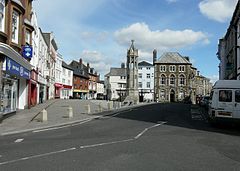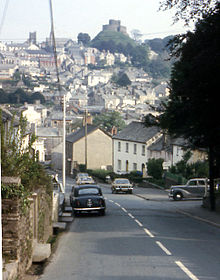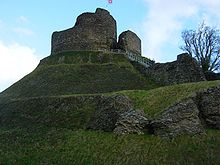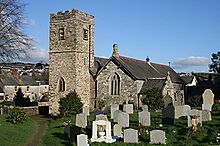- Launceston, Cornwall
-
Coordinates: 50°38′06″N 4°21′14″W / 50.635°N 4.354°W
Launceston Cornish: Lannstefan 
Town Square, Launceston
 Launceston shown within Cornwall
Launceston shown within CornwallPopulation 7,135 (2001 census[1]) OS grid reference SX335845 Parish Launceston Unitary authority Cornwall Ceremonial county Cornwall Region South West Country England Sovereign state United Kingdom Post town LAUNCESTON Postcode district PL15 Dialling code 01566 Police Devon and Cornwall Fire Cornwall Ambulance South Western EU Parliament South West England UK Parliament North Cornwall List of places: UK • England • Cornwall Launceston (
 /ˈlænsən/ lan-son, rarely /ˈlɔːns(t)ən/ lawn-ston; Cornish: Lannstefan; rarely spelled Lanson) is a town, ancient borough, and civil parish in east Cornwall, England, United Kingdom.
/ˈlænsən/ lan-son, rarely /ˈlɔːns(t)ən/ lawn-ston; Cornish: Lannstefan; rarely spelled Lanson) is a town, ancient borough, and civil parish in east Cornwall, England, United Kingdom.Dunheved was the Saxon name for the town.
Launceston is situated just over one mile (1.6 km) west of the River Tamar which marks the border between Cornwall and Devon[2] and is often referred to as the "gateway to Cornwall".
The English name is pronounced/ˈlænsən/ lan-son (traditional) or /ˈlɔːns(t)ən/ lawn-ston (less common) usually without the 't' by the Cornish, but with by non-Cornish people) The spelling form 'Lanson', phonetically based on the traditional pronunciation, is almost obsolete (some old milestones and signposts have it).
The full title of the modern civil parish is Launceston, St Mary Magdalene (which includes the town itself) and it is in the Diocese of Truro. The population of Launceston, St Mary Magdalene parish in the 2001 census was 7,135.[3]
Launceston's motto is "Royale et Loyale" from its adherence to the Royalist cause during the Civil War in the mid-17th century.
Contents
Geography
The town is built on the side of a large hill, which makes it almost immune to flooding, unlike the nearby suburb of Newport, situated at the bottom of the hill, which is susceptible to flooding by the River Kensey. Launceston is a market town and the main shopping centre for the adjoining rural areas of west Devon and east Cornwall.
Launceston is on the A30 trunk road. The road used to pass through the town centre but a dual carriageway bypass now carries traffic south of the town. The bypass crosses the River Tamar on the Dunheved Bridge which was built in the 1980s and substantially rebuilt in 2006/7.[4] Launceston is approximately 42 miles (67 km) west of Exeter, 26 miles (42 km) north of Plymouth and 21 miles (34 km) east of Bodmin. It is roughly midway between the north coast of Cornwall (at Bude) and the south coast (at Saltash).
Stourscombe SSSI, a geological Site of Special Scientific Interest, one mile to the east of Launceston, is designated ″... for the best inland exposure of the Upper Devonian in South West England and the type locality of the Stourscombe Beds (Upper Famennian).″[5]
History
The Cornish name of "Launceston", Lannstefan, means the "church of St Stephen" and is derived from the former monastery at St Stephen's a few miles north-west (the castle and town were originally named Dunheved).
The earliest known Cornish mint was at Launceston (i.e. St Stephen by Launceston), which operated on a minimal scale (before Cornwall received full diocesan jurisdiction in the year 994 AD) at the time of Ethelred II. Only one specimen is known to exist. In the reign of William I the mint was moved to Dunheved and remained in existence until the reign of Henry II, 1160.[6]
Launceston Castle, which dominates the town, is a Norman castle of motte-and-bailey design, and was built by Robert de Mortain, half-brother of William I, ca. 1070 to dominate the surrounding area. Launceston was the capital of the Earldom of Cornwall until replaced by Lostwithiel in the 13th century. Launceston was later the county town of Cornwall until 1835 when Bodmin replaced it.
During the reign of Henry III, a mint was established in Launceston. The Roman Catholic martyr Cuthbert Mayne was executed at Launceston and there are many memorials to him here.
Civil War
During the Civil War Launceston was known to be Royale et Loyale to King Charles I, hence its coat of arms. His son, the Prince of Wales, stayed in the town for a couple of days en route to the Royalist army based further west.
In 1643, the Parliamentarian forces under the command of Major General James Chudleigh advanced in an attempt to capture Launceston from the Royalists. The Royalist commander, Sir Ralph Hopton, stationed his forces on the summit of Beacon Hill, a steep hill which overlooks the town. The Parliamentarians captured the foot of the hill, but were unable to dislodge the Royalist forces from the top. Hopton led a counterattack down the hill and, despite fierce fighting and the arrival of Parliamentary reinforcements, forced Chudleigh's troops to retreat.[7]
Sir Richard Grenville was committed by Prince Charles to Launceston Prison, for refusing to obey Lord Hopton: he had already quarrelled with General George Goring.[8]
Later history
Launceston has the only document in the UK signed by Queen Mary II and her husband, William of Orange. Launceston is said to have gained its historical importance from being the furthest into Cornwall that Justices and other Officers of the Crown felt safe to venture.[citation needed] (A more realistic reason was the very poor means of transport within Cornwall at the time which did not begin to be improved until the late 18th century.) When the situation had been improved Bodmin became the county town where the assizes were held (in 1835).
Launceston was the birthplace of the notable actress Mary Ann Davenport in 1759. In the early 19th century, Launceston gave its name to the settlement which is now the second largest city in Tasmania.
Railway history
Launceston was once served by two different railway lines. The Great Western Railway (GWR) branch from Plymouth terminated in the town and the London and South Western Railway (LSWR) Exeter to Padstow North Cornwall line passed through.
Launceston's two stations were adjacent to each other (see Launceston railway station). The GWR station closed to passengers in 1952 after which all trains used the LSWR station until the North Cornwall line closed to passengers in 1966.
The Launceston Steam Railway narrow gauge railway heritage railway now runs on the trackbed of the former North Cornwall line. It runs from Launceston station west along the River Kensey valley for 2½ miles to Newmills.
Economy
The outskirts of Launceston have recently undergone rapid large business development, although the town centre has slowly become less and less commercial, with only small shops and many of those going out of business within only a few months. On the edges of the town are two industrial estates at Pennygillam and Scarne. The employment of immigrants from mainly Eastern European countries has allowed the town to sustain some of its primary industries, which the town might not otherwise have been able to support due to the low number of potential employees in the existing population.
The town has ten pubs including The White Hart, and one club called Storm. Launceston has a large number of restaurants, cafes and take aways.
Newspapers and guides
The Cornish & Devon Post is one of the newspapers for the district and its office is in the town. Several different editions of the paper and other publications are produced. It was founded in 1856 and incorporates the Launceston Weekly News.
The Cornish Guardian publishes a North Cornwall edition which covers Launceston.
Culture
Before the Reformation it is frequently mentioned in the Launceston borough accounts that minstrels were hired to play for saints day celebrations.
The poet Charles Causley was a native and long-standing resident of the town where he was both born and died. He was at one time contender for Poet Laureate and died in 2003, aged 86. He contributed the account of Launceston to a feature in the Sunday Times magazine called "Village England". He describes it as belonging to England rather than to Cornwall "[9] Launceston is one of the most important towns in Daphne du Maurier's novel Jamaica Inn.
Writer and historian, Joan Rendell lived at Yeolmbridge near Launceston.
Launceston annually hosted the "Castle Rock" music festival in July, which took place on the lower grounds of the castle which overlooks the town (within the outer walls). As well as a vibrant mix of local bands, the 2006 festival was headlined by Capdown which massively improved the event's profile. The first concert was performed in 2000 and featured a young artist who was unknown at the time, Jamie Cullum
Cornish fairings are a type of ginger biscuit commonly found in Cornwall. The recipe is reputed to have originated at the "maid hiring" fair, held the week after Christmas in Launceston.
Education
There are five schools within the town of Launceston. Launceston College caters for students aged 11 to 19, whilst the three primary schools in the town (St Catherine's Church of England Primary, St Stephen's Community Primary School and Launceston Community Primary School) cater for pupils aged 4 to 11.
There is an independent day School, 'St. Joseph's School', situated on St Stephens Hill, Launceston. St Joseph's welcomes boys and girls from age 3, going from nursery through the early years, junior department and into the senior school. Boys are being accepted into the Senior School, from Year 7 2011, and both boys and girls will be accepted into the sixth form from September 2012. For further information please click here
Launceston College was first established in 1409 and became a boys grammar school with boarding house. Famous former students include Roger Moore of James Bond fame. In 1962, Horwell Grammar School for Girls, also located in Dunheved Road, was merged with the school and in 1965 the former Pennygillam School was added to form the present day comprehensive school which is still known as Launceston College. Since the 19th century (exact date unknown) the College has been located at the southern end of Dunheved Road, approximately one kilometre from the town centre. The current College Principal is Jack Jackson (2007–present). Previous principals include Alan Wroath (1995–2007), Charlie Cooper, Danny Rowe and Henry Spencer Toy. In 1966 H Spencer Toy published 'A History of Education at Launceston', detailing the development of education in the town and surrounding area.
Launceston Community Primary School is commonly known as Windmill Primary due to its location adjacent to the site of the former windmill in Coronation Park.
Administration
Launceston was a Parliamentary Borough from medieval times, with the right to return two Members of Parliament. However, the right to vote was not held by all the residents but only by the freemen of the borough, and by the 19th century there were fewer than 50 and it had come to be regarded as a rotten borough, one of many in Cornwall. Neighbouring Newport was also a borough with two MPs of its own. Launceston lost one of its two MPs and Newport both by the Great Reform Act of 1832; the area included in the borough of Launceston was considerably extended to enable the franchise to be opened up. It finally lost its right to separate representation in 1885. It is now part of the North Cornwall parliamentary constituency. The current MP is Dan Rogerson.
Launceston was once the capital of Cornwall (before this title passed to Bodmin in 1835), and in 1973 the Prince of Wales visited to receive his feudal dues from the Duchy of Cornwall.
The arms of the town are Gu. a triple circular tower in a pyramidical form Or the first battlements mounted with cannon of the last, all within a bordure Az. charged with eight towers domed on the second. A badge was granted on Mar 26, 1906, being the first ever granted to a civic body: A keep or castle Gold.[10]
Notable buildings
Part of the town wall is still in existence including the South Gate of two arches. The White Hart Hotel incorporates a Norman doorway possibly removed from the Castle. New Bridge (early 16th century) crosses the River Tamar: it is of granite. Two old bridges cross the River Kensey: one mediaeval and one built in 1580. The Baptist chapel is late 18th century and a number of Georgian houses may also be seen.[11]
Churches
The fine Tudor church of St Mary Magdalene was built in 1511–1524 by Sir Henry Trecarrel as a memorial to his infant son who died whilst being bathed. The ornate carvings in granite originally carved for the mansion he began to build at Trecarrel, Lezant have withstood the test of time. The tower of the church dates from the 14th century, an earlier church and graveyard having previously occupied the site. The modern Roman Catholic Church is dedicated to the martyr Saint Cuthbert Mayne; it was built in the Byzantine style and opened in 1911.[12] The churches at St Stephens and St Thomas by Launceston are not in Launceston ecclesiastical parish.
There have been three Nonconformist chapels: Wesleyan Methodist, Bible Christian, and Calvinist.[13]
Sport
There are several sporting clubs in the town. These include Launceston F.C., Launceston R.F.C.,[14] a golf club, Launceston Cricket Club and Dunheved Bowling Club.
Related places and people
- Launceston is twinned with Plistin in Brittany, France.
- Launceston, Tasmania
- Viscount Launceston, a title of nobility created in 1726 (as Viscount of Launceston) but now extinct
References
- ^ neighbourhood.statistics.gov.uk
- ^ Ordnance Survey: Landranger map sheet 201 Plymouth & Launceston ISBN 9780319231463
- ^ "Launceston, St Mary Magdalene". GENUKI: UK & Ireland Genealogy. http://www.genuki.org.uk/big/eng/Cornwall/LauncestonStMaryMagdalane/. Retrieved 2006-10-29.
- ^ "Highways Agency press release: Dunheved Bridge". Highways Agency. http://www.gov-news.org/gov/uk/news/new_bridge_deck_for_a30_dunheved_bridge_launceston/59385.html. Retrieved 19 April 2010.
- ^ "Stourcombe Quarry". Natural England. http://www.sssi.naturalengland.org.uk/citation/citation_photo/1000531.pdf. Retrieved 6 November 2011.
- ^ Cornish Churh Guide (1925) Truro: Blackford; p. 198
- ^ The Civil War in the South-West, from British Civil Wars, Commonwealth, and Protectorate.
- ^ The Cornwall Register; by John Wallis (1847)
- ^ "Launceston ... still encloses a particularly secret and inward-looking community. If an eye is cast beyond itself at all it is in the direction of England: half-marooned from the rest of Cornwall as we were until a century ago by the dangerous barrier of Bodmin Moor."--Village England, p. 7
- ^ Pascoe, W. H. (1979) A Cornish Armory. Padstow: Lodenek Press; pp. 133, 136
- ^ Pevsner, N. (1970) Cornwall, 2nd ed. Penguin Books
- ^ "Launceston St Mary Magdalene". GenUKI. http://www.genuki.org.uk/big/eng/Cornwall/LauncestonStMaryMagdalane/. Retrieved 17 April 2010.
- ^ GenUKI, op. cit.
- ^ "Launceston R.F.C. website". http://www.cornishallblacks.co.uk/home/. Retrieved 2009-06-09.
External links
- Launceston Town Council
- Launceston at the Open Directory Project
- Online Catalogue for Launceston at the Cornwall Record Office
- Charles Causley Society
Geography of Cornwall Unitary authorities Major settlements Bodmin • Bude • Callington • Camborne • Camelford • Falmouth • Fowey • Hayle • Helston • Launceston • Liskeard • Looe • Lostwithiel • Marazion • Newlyn • Newquay • Padstow • Par • Penryn • Penzance • Porthleven • Redruth • Saltash • St Austell • St Blazey • St Columb Major • St Ives • St Just-in-Penwith • St Mawes • Stratton • Torpoint • Truro • Wadebridge
See also: Civil parishes in CornwallRivers Topics History • Status debate • Flag • Culture • Places • People • The Duchy • Diocese • Politics • Hundreds/shires • Places of interest • full list...Civil parishes of North Cornwall constituency  Advent • Altarnun • Blisland • Bodmin • Boyton • Bude–Stratton • Camelford • Cardinham • Davidstow • Egloshayle • Egloskerry • Forrabury and Minster • Helland • Jacobstow • Kilkhampton • Laneast • Lanhydrock • Lanivet • Launceston • Launcells • Lawhitton Rural • Lesnewth • Lewannick • Lezant • Marhamchurch • Michaelstow • Morwenstow • North Hill • North Petherwin • North Tamerton • Otterham • Padstow • Poundstock • South Petherwin • St Breock • St Breward • St Clether • St Endellion • St Ervan • St Eval • St Gennys • St Issey • St Juliot • St Kew • St Mabyn • St Merryn • St Minver Highlands • St Minver Lowlands • St Stephens by Launceston Rural • St Teath • St Thomas the Apostle Rural • St Tudy • Stoke Climsland • Tintagel • Tremaine • Treneglos • Tresmeer • Trevalga • Trewen • Wadebridge • Warbstow • Week St Mary • Werrington • Whitstone • WithielCategories:
Advent • Altarnun • Blisland • Bodmin • Boyton • Bude–Stratton • Camelford • Cardinham • Davidstow • Egloshayle • Egloskerry • Forrabury and Minster • Helland • Jacobstow • Kilkhampton • Laneast • Lanhydrock • Lanivet • Launceston • Launcells • Lawhitton Rural • Lesnewth • Lewannick • Lezant • Marhamchurch • Michaelstow • Morwenstow • North Hill • North Petherwin • North Tamerton • Otterham • Padstow • Poundstock • South Petherwin • St Breock • St Breward • St Clether • St Endellion • St Ervan • St Eval • St Gennys • St Issey • St Juliot • St Kew • St Mabyn • St Merryn • St Minver Highlands • St Minver Lowlands • St Stephens by Launceston Rural • St Teath • St Thomas the Apostle Rural • St Tudy • Stoke Climsland • Tintagel • Tremaine • Treneglos • Tresmeer • Trevalga • Trewen • Wadebridge • Warbstow • Week St Mary • Werrington • Whitstone • WithielCategories:- Civil parishes in Cornwall
- Towns in Cornwall
- Cornish capitals
- History of Cornwall
Wikimedia Foundation. 2010.








